Balkinization
an unanticipated consequence of
Jack M. Balkin
Balkinization Symposiums: A Continuing List
E-mail:
Jack Balkin:
jackbalkin at yahoo.com
Bruce Ackerman
bruce.ackerman at yale.edu
Ian Ayres
ian.ayres at yale.edu
Corey Brettschneider
corey_brettschneider at brown.edu
Mary Dudziak
mary.l.dudziak at emory.edu
Joey Fishkin
joey.fishkin at gmail.com
Heather Gerken heather.gerken at yale.edu
Abbe Gluck abbe.gluck at yale.edu
Mark Graber
mgraber at law.umaryland.edu
Stephen Griffin
sgriffin at tulane.edu
Jonathan Hafetz
jonathan.hafetz at shu.edu
Jeremy Kessler
jkessler at law.columbia.edu
Andrew Koppelman
akoppelman at law.northwestern.edu
Marty Lederman
msl46 at law.georgetown.edu
Sanford Levinson
slevinson at law.utexas.edu
David Luban
david.luban at gmail.com
Gerard Magliocca
gmaglioc at iupui.edu
Jason Mazzone
mazzonej at illinois.edu
Linda McClain
lmcclain at bu.edu
John Mikhail
mikhail at law.georgetown.edu
Frank Pasquale
pasquale.frank at gmail.com
Nate Persily
npersily at gmail.com
Michael Stokes Paulsen
michaelstokespaulsen at gmail.com
Deborah Pearlstein
dpearlst at yu.edu
Rick Pildes
rick.pildes at nyu.edu
David Pozen
dpozen at law.columbia.edu
Richard Primus
raprimus at umich.edu
K. Sabeel Rahmansabeel.rahman at brooklaw.edu
Alice Ristroph
alice.ristroph at shu.edu
Neil Siegel
siegel at law.duke.edu
David Super
david.super at law.georgetown.edu
Brian Tamanaha
btamanaha at wulaw.wustl.edu
Nelson Tebbe
nelson.tebbe at brooklaw.edu
Mark Tushnet
mtushnet at law.harvard.edu
Adam Winkler
winkler at ucla.edu
Compendium of posts on Hobby Lobby and related cases
The Anti-Torture Memos: Balkinization Posts on Torture, Interrogation, Detention, War Powers, and OLC
The Anti-Torture Memos (arranged by topic)
Recent Posts
Competitive Federalism and Collective Action Federalism
Just A Few Blogs
ACS Blog
Alas, a Blog
Althouse
Arts and Letters Daily
Atrios (Eschaton)
Bill of Health
Buzzflash.com
Buzz Machine
Cato at Liberty
Juan Cole (Informed Comment)
Concurring Opinions
The Constitution in 2020
Corrente
Crooked Timber
Daily Howler
Daily Kos
Dana Boyd
Brad DeLong
Digby (Hullabaloo)
Discriminations
Daniel Drezner
Kevin Drum (Mother Jones)
Electrolite
En Banc
Eunomia (Daniel Larison)
Fafblog
Michael Froomkin (Discourse.net)
GovLab (Beth Noveck)
Rick Hasen (Election Law)
History News Network
How Appealing
Ignatz (Sam Heldman)
The Importance of (Ernie Miller)
Infolaw
Instapundit
International Economic Law and Policy Blog
IntLawGrrls
Jacob Levy
Jesus' General
Jurisdynamics
The Kitchen Cabinet
Mark Kleiman
Law Blog Central
Larry Lessig
Lawyers, Guns and Money
Liberal Oasis
Brian Leiter's Law School Reports
The Leiter Reports
Marginal Revolution
Megan McArdle
Memeorandum
Metafilter
Mirror of Justice
The New Republic
Newseum
No More Mister Nice Blog
Brendan Nyhan
Opinio Juris
Orcinus
The Originalism Blog
Pandagon
Passport (Foreign Policy)
Overcoming Bias
Political Animal (Washington Monthly)
Political Theory Daily Review
Political Wire (Taegan Goddard)
The Poor Man
Virginia Postrel
Prawfsblawg
Public Reason
Jonathan Rauch
Raw Story
Redstate
ReligiousLeftLaw.com
Reporters Committee For Freedom of the Press
Reproductive Rights Blog
Rothman's Roadmap to the Right of Publicity
SCOTUS Blog
Seeing the Forest
Clay Shirky
The Shifted Librarian
The Situationist
Larry Solum (Legal Theory)
Andrew Sullivan
Talking Points Memo
Talk Left
Tapped
Tbogg
TechPresident
The Paper Chase (Jurist)
Tom Paine
Tom Tomorrow (This Modern World)
Eve Tushnet
Uggabugga
University of Chicago Law School Faculty Blog
Unqualified Offerings
The Volokh Conspiracy
War and Piece (Laura Rozen)
Wampum
Oliver Willis
Wonkette
Written Description
Matthew Yglesias
Yin
Your Choice of Feeds
1. XML
powered by
2. Atom Feed
3. RSS 2.0
Competitive Federalism and Collective Action Federalism
Neil Siegel
For the symposium on Michael Greve's The Upside Down Constitution (Harvard University Press 2012).
Mazel Tov to my friend Michael Greve, who has written a comprehensive and insightful book on American constitutional federalism. In The Upside-Down Constitution, he argues that a structural constitutional principle binds together many of the federalism provisions in the U.S. Constitution. According to his theory of competitive federalism, the Constitution requires a system of governance in which states compete with one another for businesses and citizens. Greve does not maintain that the Framers or Founders of 1787 had a commitment to competition among states explicitly in mind. For example, he concedes that his champion, James Madison, missed the crucial importance of mobility to ensuring a competitive constitutional regime. But Greve does argue that a commitment to competition makes the best structural sense of the Constitution that the Framers drafted and the People ratified.
I have advocated a different structural theory of constitutional federalism, one that I have developed with Robert Cooter and refined on my own. The theory of collective action federalism understands the expanse and limits of congressional power in Article I, Section 8, as well as certain limits on state power in Article I, Section 10, and Article IV, in light of the collective action problems that the nation faced under the Articles of Confederation, when Congress lacked the powers to tax, regulate interstate commerce, raise and support a military, and act directly on individuals. The collective action principle distinguishes problems whose solution requires separate action by states from problems whose solution requires collective action by states.
The presence or absence of multi-state collective action problems is central to understanding the scope of federal power in the clauses of Article I, Section 8. These clauses mostly concern collective action problems created by interstate externalities and interstate markets. A prominent example is the Commerce Clause, which empowers Congress to regulate commerce “among the several States” but not commerce that is internal to a state.
Collective action federalism’s structural account of Article I, Section 8 draws substantial support from constitutional text, history, and much judicial precedent. For instance, the Framers understood collective action problems well; indeed, the pervasiveness of such problems facing the states during the Critical Period of the 1780s inspired the Constitutional Convention.
The collective action principle also makes functional sense. It flows directly from the relative advantages of the federal and state governments. Much of what the federal government does better than the states is solve collective action problems that the states cannot deal with as effectively on their own.
What is the relationship between Greve’s theory of competitive federalism and the theory of collective action federalism? There are obvious similarities in interpretive orientation. While Greve and I agree that each constitutional provision possesses its own distinctive meaning, we are both structuralists at heart on matters of constitutional federalism: we inquire into the underlying purposes of many of the Constitution’s federalism-related provisions considered as an architectural whole. We ask how the federalism components of the constitutional machine work or are supposed to work in practice. And in answering that question, we bring to bear tools and insights of modern economic analysis.
We also agree on some particulars. For instance, we both believe that there is a strong structural justification for a robust dormant commerce principle.
One might be tempted to see further similarities in our approaches. One might regard both of our efforts as really attempts to reason about what a federal republic ought to look like based on first principles of political economy. One this view, Cooter and I do not claim that the Framers reasoned precisely in our terms; rather, we claim that their accomplishment is consistent with sound economic theory. Likewise, the Framers did not have a theory of competitive federalism is mind, but Greve argues that their work product makes the most sense in terms of that theory.
Perhaps uncharitably, I tend to see Greve’s effort in such a light—not entirely, but to a significant extent. I read him mostly as reasoning his way from an extra-legal, Rawlsian “original position” to advocacy of a Constitution that is more friendly to business and wealthy Americans. The social science evidence allows us to be reasonably confident about the consequences of robust interjurisdictional competition: it restrains welfare state growth by causing states to limit the taxation that supports redistributive policies for fear that businesses and wealthy individuals will leave and more economically vulnerable people will enter. I did not encounter in Greve’s book (though I may have missed it) any evidence that any of the Founders anticipated such a dynamic and approved of it.
Grieve is, to my mind, more persuasive in seeing a commitment to competitive federalism in the Supreme Court’s jurisprudence of the Gilded Age. But the normative authority of such precedent is, in my view, very limited.
I do not understand the theory of collective action federalism as really just an exercise in constitutional design. I see substantially more legal support for collective action federalism than for competitive federalism.
Consider, for example, founding history. Of course the Framers and ratifiers lacked the tools and language of modern collective action theory. But they were living with substantial collective action problems under the Articles; they knew it; they described it; and they intended for the Constitution to do something about it.
For example, James Madison registered the existence of collective action problems in his Vices of the Political System of the United States, a memorandum he wrote while preparing for the Constitutional Convention. Recording various problems with the Articles, Madison underscored “want of concert in matters where common interest requires it,” a “defect . . . strongly illustrated in the state of our commercial affairs. How much has the national dignity, interest, and revenue suffered from this cause?” When activities spilled over from one state to another, Madison and other nationalist Framers recognized that the actions of individually rational states produced irrational results for the nation.
With Madison, the delegates at the Philadelphia Convention focused on collective action problems facing the states in considering the scope of congressional power that would become Article I, Section 8. The Convention instructed the midsummer Committee of Detail that Congress would have authority “to legislate in all Cases for the general Interests of the Union, and also in those Cases to which the States are separately incompetent, or in which the Harmony of the United States may be interrupted by the Exercise of individual Legislation.” This language of separate state incompetence apprehends the need to address collective action problems facing the states. It tracks statements made by James Wilson during the Pennsylvania ratifying convention. It also tracks Madison’s statement in THE FEDERALIST NO. 14 that the legislative jurisdiction of Congress “is limited to certain enumerated objects, which concern all the members of the republic, but which are not to be attained by the separate provisions of any. The subordinate governments . . . can extend their care to all those other subjects which can be separately provided for . . .” (my emphases).
Turning from history to doctrine, a collective action approach finds support in seminal decisions of the Marshall Court: McCulloch v. Maryland and Gibbons v. Ogden. Collective action federalism also offers a multi-generational synthesis of almost all of the Supreme Court’s Commerce Clause decisions since 1937, explaining why Wickard v. Filburn and Gonzales v. Raich belong on one side of the constitutional line and why United States v. Lopez and United States v. Morrison belong on the other. The Commerce Clause conclusion of five Justices in NFIB v. Sebelius is problematic from a collective action perspective, but it is reconcilable with a collective action approach to the extent one regards a ban on purchase mandates as an independent limit on Congress akin to commandeering. (For substantiation of these claims, see my analyses of the doctrine in the pieces linked above.)
I do not read Greve as rejecting the view that the collective action principle justifies many uses of the Commerce Clause; on the contrary, at times he seems to endorse it. But I suspect that he would define a collective action problem more narrowly than I do. (I define it to include material interstate externalities regardless of whether they cause races to the bottom.) I also suspect that he would have courts greet collective action justifications for federal power more skeptically than I would. More generally, Greve wants an aggressive—he would say “engaged”—federal judiciary.
For example, Greve dismisses the claim that different state laws and practices concerning child labor were causing a race to the bottom during the early 1900s. Collective action federalism views child labor as a textbook example of a problem warranting use of the Commerce and Taxing Clauses. Contrary to Greve, the fact that Southern states eventually reduced and nearly eliminated child labor on their own does not suggest that there never really was a race to the bottom, or that Congress should have waited. In the long run we are all dead, children included.
The differences between competitive federalism and collective action federalism may be greatest on the question of how to define the scope of multistate collective action problems. Where Greve sees anti-competitive cartels, I see permissible attempts to cooperate in just the way that the states failed to cooperate during the Critical Period. Competitive federalism views many of the results justified by collective action federalism as the establishment of state cartels that prevents healthy competition among the states. Collective action federalism views the Constitution as empowering Congress to combat destructive competition among states and to internalize other interstate externalities.
Collective action federalism is reconcilable with competitive federalism in the sense that collective action federalism permits the sort of politics that competitive federalism desires. If enough Americans want an anti-redistributive politics, then the Collective Action Constitution will not deny them. But collective action federalism rejects the suggestion that such a politics is the Constitution’s command. Collective action federalism seeks, among other things, to make sense of post-1937 constitutional law. Competitive federalism seeks to destroy it.
Posted
12:30 PM
by Neil Siegel [link]
Books by Balkinization Bloggers

Gerard N. Magliocca, The Actual Art of Governing: Justice Robert H. Jackson's Concurring Opinion in the Steel Seizure Case (Oxford University Press, 2025)

Linda C. McClain and Aziza Ahmed, The Routledge Companion to Gender and COVID-19 (Routledge, 2024)

David Pozen, The Constitution of the War on Drugs (Oxford University Press, 2024)

Jack M. Balkin, Memory and Authority: The Uses of History in Constitutional Interpretation (Yale University Press, 2024)
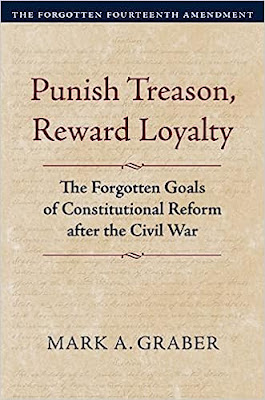
Mark A. Graber, Punish Treason, Reward Loyalty: The Forgotten Goals of Constitutional Reform after the Civil War (University of Kansas Press, 2023)
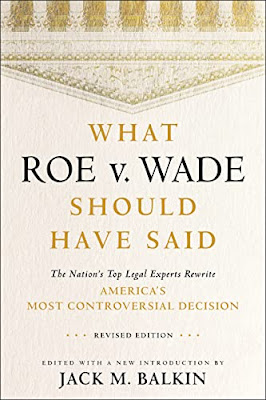
Jack M. Balkin, What Roe v. Wade Should Have Said: The Nation's Top Legal Experts Rewrite America's Most Controversial Decision - Revised Edition (NYU Press, 2023)

Andrew Koppelman, Burning Down the House: How Libertarian Philosophy Was Corrupted by Delusion and Greed (St. Martin’s Press, 2022)

Gerard N. Magliocca, Washington's Heir: The Life of Justice Bushrod Washington (Oxford University Press, 2022)
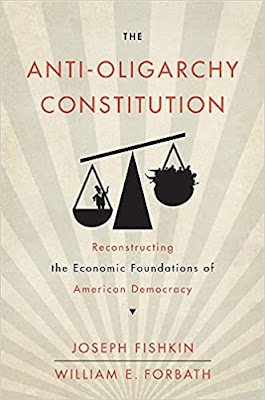
Joseph Fishkin and William E. Forbath, The Anti-Oligarchy Constitution: Reconstructing the Economic Foundations of American Democracy (Harvard University Press, 2022)
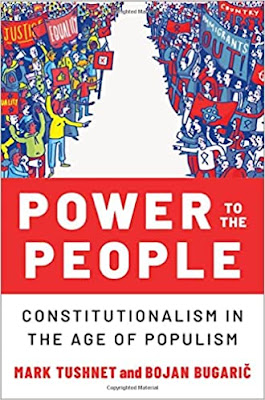
Mark Tushnet and Bojan Bugaric, Power to the People: Constitutionalism in the Age of Populism (Oxford University Press 2021).

Mark Philip Bradley and Mary L. Dudziak, eds., Making the Forever War: Marilyn B. Young on the Culture and Politics of American Militarism Culture and Politics in the Cold War and Beyond (University of Massachusetts Press, 2021).

Jack M. Balkin, What Obergefell v. Hodges Should Have Said: The Nation's Top Legal Experts Rewrite America's Same-Sex Marriage Decision (Yale University Press, 2020)

Frank Pasquale, New Laws of Robotics: Defending Human Expertise in the Age of AI (Belknap Press, 2020)

Jack M. Balkin, The Cycles of Constitutional Time (Oxford University Press, 2020)

Mark Tushnet, Taking Back the Constitution: Activist Judges and the Next Age of American Law (Yale University Press 2020).

Andrew Koppelman, Gay Rights vs. Religious Liberty?: The Unnecessary Conflict (Oxford University Press, 2020)

Ezekiel J Emanuel and Abbe R. Gluck, The Trillion Dollar Revolution: How the Affordable Care Act Transformed Politics, Law, and Health Care in America (PublicAffairs, 2020)

Linda C. McClain, Who's the Bigot?: Learning from Conflicts over Marriage and Civil Rights Law (Oxford University Press, 2020)
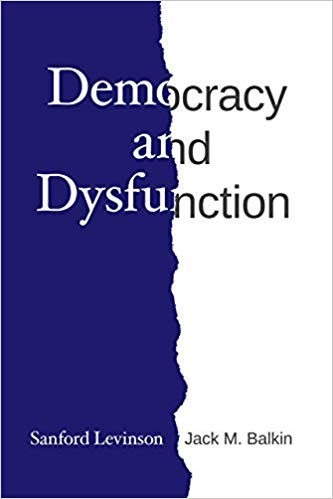
Sanford Levinson and Jack M. Balkin, Democracy and Dysfunction (University of Chicago Press, 2019)

Sanford Levinson, Written in Stone: Public Monuments in Changing Societies (Duke University Press 2018)

Mark A. Graber, Sanford Levinson, and Mark Tushnet, eds., Constitutional Democracy in Crisis? (Oxford University Press 2018)

Gerard Magliocca, The Heart of the Constitution: How the Bill of Rights became the Bill of Rights (Oxford University Press, 2018)

Cynthia Levinson and Sanford Levinson, Fault Lines in the Constitution: The Framers, Their Fights, and the Flaws that Affect Us Today (Peachtree Publishers, 2017)

Brian Z. Tamanaha, A Realistic Theory of Law (Cambridge University Press 2017)

Sanford Levinson, Nullification and Secession in Modern Constitutional Thought (University Press of Kansas 2016)

Sanford Levinson, An Argument Open to All: Reading The Federalist in the 21st Century (Yale University Press 2015)

Stephen M. Griffin, Broken Trust: Dysfunctional Government and Constitutional Reform (University Press of Kansas, 2015)

Frank Pasquale, The Black Box Society: The Secret Algorithms That Control Money and Information (Harvard University Press, 2015)

Bruce Ackerman, We the People, Volume 3: The Civil Rights Revolution (Harvard University Press, 2014)
Balkinization Symposium on We the People, Volume 3: The Civil Rights Revolution

Joseph Fishkin, Bottlenecks: A New Theory of Equal Opportunity (Oxford University Press, 2014)

Mark A. Graber, A New Introduction to American Constitutionalism (Oxford University Press, 2013)

John Mikhail, Elements of Moral Cognition: Rawls' Linguistic Analogy and the Cognitive Science of Moral and Legal Judgment (Cambridge University Press, 2013)

Gerard N. Magliocca, American Founding Son: John Bingham and the Invention of the Fourteenth Amendment (New York University Press, 2013)

Stephen M. Griffin, Long Wars and the Constitution (Harvard University Press, 2013)

Andrew Koppelman, The Tough Luck Constitution and the Assault on Health Care Reform (Oxford University Press, 2013)

James E. Fleming and Linda C. McClain, Ordered Liberty: Rights, Responsibilities, and Virtues (Harvard University Press, 2013)
Balkinization Symposium on Ordered Liberty: Rights, Responsibilities, and Virtues

Andrew Koppelman, Defending American Religious Neutrality (Harvard University Press, 2013)

Brian Z. Tamanaha, Failing Law Schools (University of Chicago Press, 2012)

Sanford Levinson, Framed: America's 51 Constitutions and the Crisis of Governance (Oxford University Press, 2012)

Linda C. McClain and Joanna L. Grossman, Gender Equality: Dimensions of Women's Equal Citizenship (Cambridge University Press, 2012)

Mary Dudziak, War Time: An Idea, Its History, Its Consequences (Oxford University Press, 2012)

Jack M. Balkin, Living Originalism (Harvard University Press, 2011)

Jason Mazzone, Copyfraud and Other Abuses of Intellectual Property Law (Stanford University Press, 2011)

Richard W. Garnett and Andrew Koppelman, First Amendment Stories, (Foundation Press 2011)

Jack M. Balkin, Constitutional Redemption: Political Faith in an Unjust World (Harvard University Press, 2011)

Gerard Magliocca, The Tragedy of William Jennings Bryan: Constitutional Law and the Politics of Backlash (Yale University Press, 2011)

Bernard Harcourt, The Illusion of Free Markets: Punishment and the Myth of Natural Order (Harvard University Press, 2010)

Bruce Ackerman, The Decline and Fall of the American Republic (Harvard University Press, 2010)
Balkinization Symposium on The Decline and Fall of the American Republic

Ian Ayres. Carrots and Sticks: Unlock the Power of Incentives to Get Things Done (Bantam Books, 2010)

Mark Tushnet, Why the Constitution Matters (Yale University Press 2010)
Ian Ayres and Barry Nalebuff: Lifecycle Investing: A New, Safe, and Audacious Way to Improve the Performance of Your Retirement Portfolio (Basic Books, 2010)
.jpg)
Jack M. Balkin, The Laws of Change: I Ching and the Philosophy of Life (2d Edition, Sybil Creek Press 2009)

Brian Z. Tamanaha, Beyond the Formalist-Realist Divide: The Role of Politics in Judging (Princeton University Press 2009)
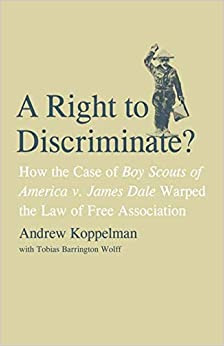
Andrew Koppelman and Tobias Barrington Wolff, A Right to Discriminate?: How the Case of Boy Scouts of America v. James Dale Warped the Law of Free Association (Yale University Press 2009)

Jack M. Balkin and Reva B. Siegel, The Constitution in 2020 (Oxford University Press 2009)
Heather K. Gerken, The Democracy Index: Why Our Election System Is Failing and How to Fix It (Princeton University Press 2009)

Mary Dudziak, Exporting American Dreams: Thurgood Marshall's African Journey (Oxford University Press 2008)

David Luban, Legal Ethics and Human Dignity (Cambridge Univ. Press 2007)

Ian Ayres, Super Crunchers: Why Thinking-By-Numbers is the New Way to be Smart (Bantam 2007)

Jack M. Balkin, James Grimmelmann, Eddan Katz, Nimrod Kozlovski, Shlomit Wagman and Tal Zarsky, eds., Cybercrime: Digital Cops in a Networked Environment (N.Y.U. Press 2007)
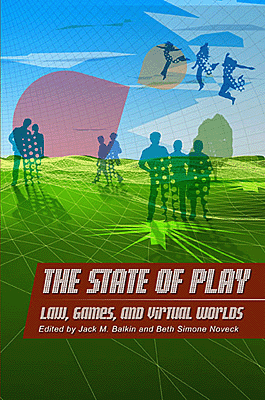
Jack M. Balkin and Beth Simone Noveck, The State of Play: Law, Games, and Virtual Worlds (N.Y.U. Press 2006)

Andrew Koppelman, Same Sex, Different States: When Same-Sex Marriages Cross State Lines (Yale University Press 2006)
Brian Tamanaha, Law as a Means to an End (Cambridge University Press 2006)
Sanford Levinson, Our Undemocratic Constitution (Oxford University Press 2006)
Mark Graber, Dred Scott and the Problem of Constitutional Evil (Cambridge University Press 2006)
Jack M. Balkin, ed., What Roe v. Wade Should Have Said (N.Y.U. Press 2005)
Sanford Levinson, ed., Torture: A Collection (Oxford University Press 2004)
Balkin.com homepage
Bibliography
Conlaw.net
Cultural Software
Writings
Opeds
The Information Society Project
BrownvBoard.com
Useful Links
Syllabi and Exams